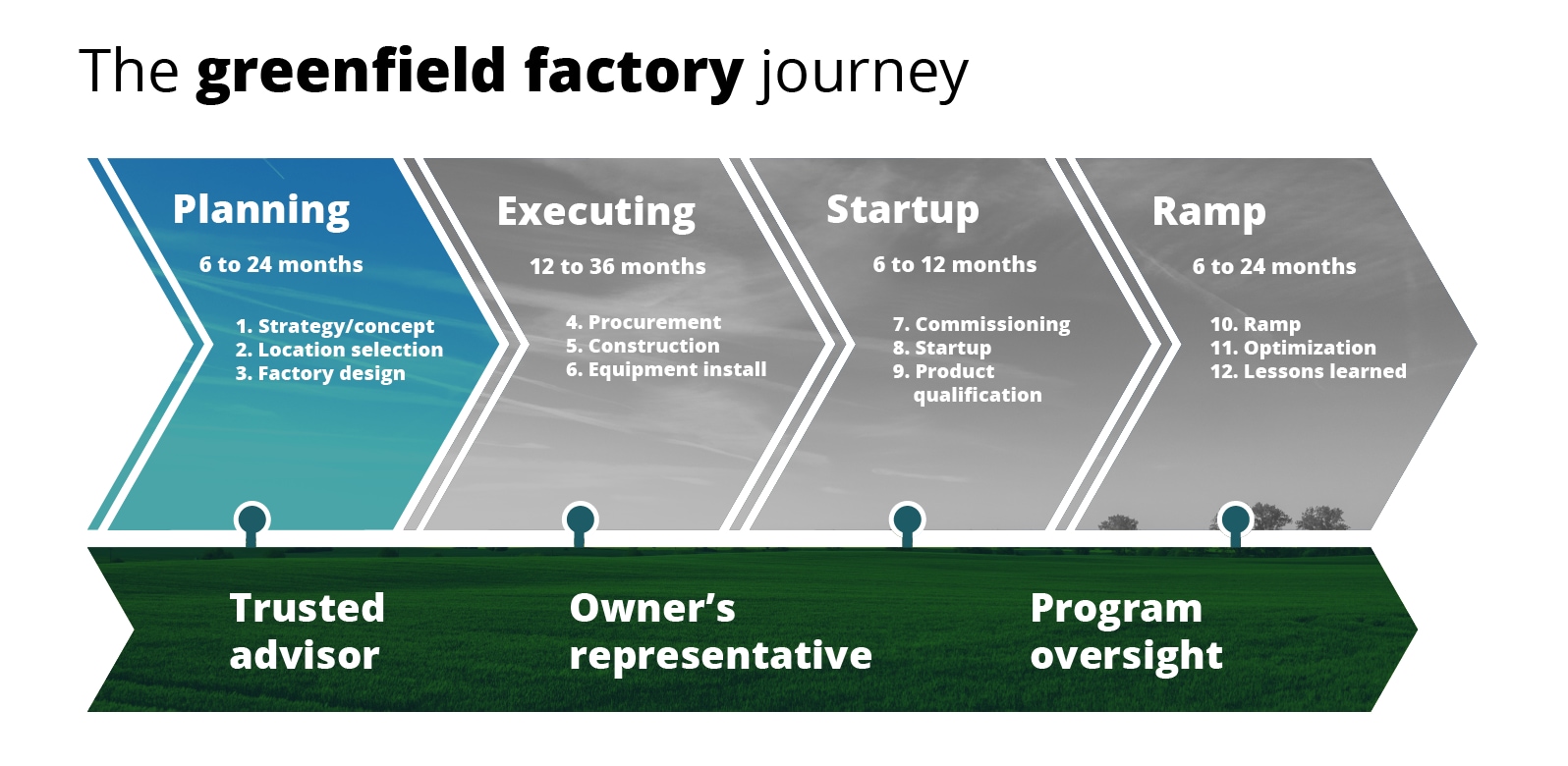The greenfield factory journey: Phase 1 has been saved

Perspectives
The greenfield factory journey: Phase 1
Planning, selecting, and developing a greenfield site
In part 1 of our four-part article series detailing Deloitte’s greenfield factory journey, we explore the planning process, from manufacturing strategy and initial concept to site selection and factory design.
Planning your greenfield factory
Developing a greenfield site and bringing it online can take three to five years, so we’ve broken down the journey into four phases and 12 steps. The initial planning phase is arguably the most important as you properly define the objectives and manufacturing strategy of your greenfield factory. It is important to strike a balance between meeting short-term objectives, such as producing new revenue as quickly as possible, with long-term objectives, such as being able to scale.
The planning phase is also where it is least expensive to change course, redesign, push out, or even consider expanding the original scope. During planning, manufacturing companies can weigh the pros and cons of multiple locations, and once a final site is selected, your detailed factory design can start.

Step 1: Strategy and concept
As you contemplate developing a new greenfield manufacturing site, there are several strategic factors that can shape the decision and how to move forward. Clearly articulating these nine objectives up front and clarifying guiding principles will help frame the business case and get key stakeholders on board.
- Capacity expansion—Building a new factory is an opportunity to add significant capacity and accommodate projected growth.
- New manufacturing capabilities—New innovative products may require capabilities that don’t currently exist within the network and retooling existing production lines may be too costly or disruptive. Software-defined processes and tooling can increase manufacturing agility and flexibility.
- De-risking the supply chain—Having two or more factories that can produce the same product significantly reduces the risk of supply disruptions for customers—and may be the differentiator to winning business.
- Distributed manufacturing—Decoupling where components and subassemblies are produced may be beneficial in reducing overall shipping costs and increasing agility.
- Co-op manufacturing—When manufacturing partners (i.e., product manufacturers and packaging manufacturers) work together and co-locate in the same facility, existing infrastructure, machinery, and expertise can be leveraged to reduce upfront investment.
- Reducing costs—A greenfield factory may be an opportunity to install the latest automation and Industry 4.0 smart technology, which enables the least possible unit cost.
- Tighter process control—As manufacturing technology rapidly advances, a new greenfield factory may be designed with equipment and processes that achieve the best process control and highest quality.
- Reducing time to market—A new greenfield factory may also enable faster time to market due to new capacity, location, and/or new manufacturing capabilities.
- Government subsidies—Sizable government incentives may be available and could be a significant consideration in the greenfield strategy.
Step 2: Greenfield factory site selection
Geography is a key driver of corporate performance. Yet many organizations maintain inefficient footprints that can hamper talent attraction and retention, increase operating costs, reduce operating flexibility, overexpose them to risk, and depress shareholder value. Additionally, most companies do not effectively evaluate and react to business changes. Some make footprint decisions at the sub-enterprise level (e.g., business unit or region), while others stay put while the world changes around them.
By enhancing “locational awareness” and implementing an enterprise-wide site selection and footprint strategy, companies can more efficiently position assets in the right place at the right time and strike a balance between market access, talent availability, risk mitigation, and cost containment. Consider these key areas during the site selection process:
Labor market
Labor costs are rising rapidly, but not proportionally across all regions or locales. In order to keep your cost structure within targets, carefully evaluate the labor markets where new factory locations are being considered. It is also important to think about the nearby labor supply. While qualified workers may be ample within the region, if most of those people are not located within 30 minutes, you may have a difficult time recruiting and retaining the labor you need to launch and sustain your greenfield factory.
Infrastructure and logistics
Water, electricity, gas, and proximity to major transportation infrastructure may be significant factors in your decision to select one site over another. Use economic development agencies, utility companies, and real estate developers to get a lay of the land. Feed this data into a cost model and decision framework to produce the right set of recommendations.
Incentives and negotiations
Navigating and evaluating potential incentives from local, state, or federal governments may be challenging. Most manufacturers don’t have dedicated staff with the experience and capacity to effectively gather facts and understand the complexities of opportunities such as tax incentive programs and grant funding. Depending on the situation, find the right experts to help identify the options and begin a dialogue with government leaders to see what is possible. Advising through a long negotiation process may be a significant consideration as well.
Step 3: Factory design begins
As the parcel of land is identified, high-level design and programming can begin as the next phase of your greenfield site development. Greenfield capacity expansions offer an opportunity to avoid repeating past mistakes and design things right. Leveraging factory digital twins for model-based simulations is an option to explore various scenarios to optimize the factory design. Here are a few things to consider during the design phase:
How Deloitte can help the greenfield factory journey
With deep expertise across industries, Deloitte has helped many leading global companies develop a greenfield site. No matter where you are in the journey, we can help you get back on track and realize your ultimate greenfield goals, using new methodologies that reduce risk, improve performance, and save time and money.
As a strategic partner, our smart manufacturing team can also fill knowledge gaps across tax strategy, consulting, financial advisory, risk advisory, and business process transformation. Contact us today to learn how we can work together to bring your greenfield vision to life.

Optimize your Greenfield smart factory with Deloitte
Interested in learning more? Complete the form below and we’ll get in touch.
Get in touch

Principal, Deloitte Consulting LLP
Smart Manufacturing Senior Commercial Advisor
${fourth-leader-name}
${fourth-leader-title}
${fourth-leader-additional-info}
Recommendations
Accelerate sustainability in process manufacturing
Get to net-zero faster with smart manufacturing
Laying the foundation for smart factory enhancements
Smart factory MES compounds value




